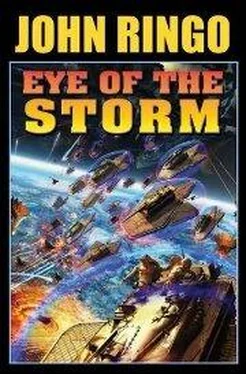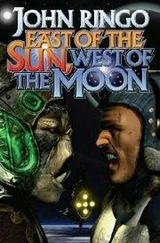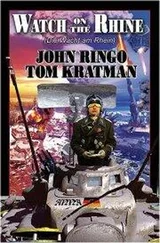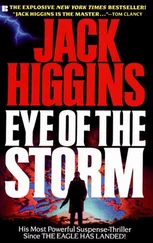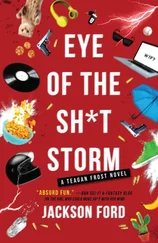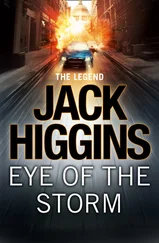Eye of the Storm
by John Ringo
To Jim Baen, my mentor, my publisher and my friend.
Just trying to pay forward.
I’d like to thank some people for their help in finally getting this novel done.
Jim Baen, deceased by three days when I finally figured out how to continue the story of Michael O’Neal. Because I swear to God I heard him say “do it this way, Johnny”. This one’s for you, Jim.
Miriam Sloan for back rubs, hot tea and just being her.
Rogue, Jessica and the rest of Cruxshadows.
Tom Kratman and Julie Cochrane for expanding the vision of the Aldenata universe and the characters therein. And for telling me ‘It’s done, John. Turn it in.’
Ben-David Singleton for actually organizing my randomized characters, systems and TOE.
The various members of RingTAB for corrections of some very obvious errors.
Conrad Chu, PhD and Doug Miller, USAR for physics and electrical help, respectively.
Now on with the show.
The trials you now are facing
They are not greater than your will
For there is nothing under heaven
You cannot overcome
Cruxshadows
Eye of the Storm
As its defenses crumbled, a Posleen penetrator finally latched onto the side glassis armor of the Richard Waechter and began burrowing.
Even the multi-thousand ton bulk of a SheVa Mark VII continental siege unit could only carry its heaviest armor forward. The side glassis was composed of only two hundred centimeters of ultra-dense, ultra-strong composite made only by the finest Indowy craftsmen. The Posleen smart round first deformed to create an armored beachhead on the hull then shot a concentrated jet of fusion-generated plasma, burning rapidly through the refractory armor. Once a hole was created into the meaty center, it shot an armored penetrator containing a bare ten micrograms of antimatter into the compartmented interior.
The fourteen man crew of the SheVa knew that once a breacher round was on the hull, it was virtually impossible to remove; your best bet of survival was bailing out. The three Taylor Class Heavy Armored Escape Vehicles dropped from under the SheVa and bolted to the rear. They were picked off by plasma fire from the Posleen redoubt even as the SheVa gouted fire from every hatch and the six thousand ton turret lifted fifty meters into the air on an actinic ball of nuclear fire.
As soon as the last SheVa was eliminated, the Posleen popped up a casta round. The maneuvering HVM quickly scattered its load of antimatter bomblets across the front of the approaching line of ACS and disintegrated as the last one detonated.
One hundred and ninety-nine more bomblets detonated almost simultaneously, each the equivalent of sixteen megatonnes of TNT.
As soon as the icon of the casta round appeared on his heads up display, Private Julio Garcia dropped a foxhole round to the ground and crouched, hoping against hope that the round would dig out a hole for him before the casta went off. Shooting the bomblets was futile, that would only make them detonate earlier. The only thing that the armored combat suit corps could do was dig in and try to ride out the detonation. The Indowy manufactured battle armor was very tough indeed but a 16 megaton explosion had a better than even chance of ripping even an ACS suit into itsy bitsy pieces.
As the dirt of R-1496 Delta fountained upwards the armored infantryman dove for the hole. It was times like this that he seriously reconsidered his decision to leave the hell of New Chicago.
Julio was twenty-three, very young for a private in the ACS. He’d been raised in the New Chicago Sub-Urb, an underground city left over from the Posleen invasion of Earth. The refuges had, by and large, done their job of keeping a core of civilization alive throughout the siege but most people got out of them as quickly as possible as soon as the Posleen menace was relieved.
However, in any refugee situation a core, usually running about ten percent, refused to leave the camp or, in this case, underground city. Whether from laziness or ongoing paranoia over what had driven them to the refuge, the “refuseniks” were a problem in any recovery period.
Earth’s government had responded by slowly concentrating them. As each Sub-Urb slowly regurgitated its refugee population, those who preferred to remain in the Urbs were moved to other Urbs and slowly concentrated. Once the refuseniks were fully concentrated in four or five Urbs, they were essentially left to rot.
Minimal and generally unpalatable food was available. Enter one of the eating areas, swipe your implanted chip and you’d be given a measured amount of glop. The brown, unappetizing substance was nutritious and even filling but it had the consistency of wet cardboard and about the same taste.
There was no work in the Urbs and it wasn’t so much that crime was rife as that was the only business going. They were centers for drug trafficking, illegal arms sales (and in the post-war world you had to work for a weapon to be illegal) and prostitution. Indeed, many people thought the only reason they still existed was so that all the criminals could be concentrated in one place. The general opinion of surfacers was that the best use of the Urbs was as dumping grounds and that eventually the government would just toss in some gas bombs and be done with them.
Julio had been in the gangs, it was the only way to survive. And he’d dealt and run and even killed to survive in the Urb. But he didn’t have a criminal record. The few police in the Urbs concentrated on securing the food centers and making sure nobody did anything bad to the fundamental infrastructure. What happened outside those few secure areas rarely came to their attention. Even when it did, they didn’t care.
“You were raped? That’s tough, Miss. Maybe you should move elsewhere.”
There were few ways out of the Urbs. There was no great labor shortage on the surface and surfacers considered Urbers as the lowest of the lowest scum. After the loss of dozens of colonist ships to various accidents and ‘unanticipated Posleen deep space attacks,’ colonization became far less attractive.
There was one way not only out of the Urbs but to a pretty good life, but it depended on surviving it. The military was always recruiting. It had been tasked with “recovery” of the Posleen blight zone, a three hundred light year stretch of the galaxy composed of little but stars and planets either originally uninhabitable or turned into radioactive wastelands. As the Posleen advanced they stripped the planets they took and then, far more often then not, fell out into destructive planet-wide wars that left the world a blasted hulk. But even a hulk had some value. Indowy deep miners could still extract minerals and once their ship-like megascrapers were installed, the Indowy could build factories, live and work anywhere that there was a semblance of an atmosphere. They didn’t care what the world looked like, they just wanted room for their rapidly expanding population.
So the pattern was established. The Fleet, and Fleet Strike, it’s ground and fighter arm, would wipe a planet of concentrated Posleen infestations. Then a specialty human company would come in and establish a fully cleared zone. Last the Indowy would arrive, build their megascrapers using techology that looked a bit too much like wizardry and move in. Other human security companies would ensure the safety of the burgeoning cities, keeping the Posleen out when they could and killing any that penetrated into the megascrapers.
That was the job Julio was after, a nice safe gig with a security company. But they didn’t recruit in the Urbs. They wanted trained soldiers. So first you had to spend time in Fleet’s security arm, the FP bully-boys, or in one of the infantry arms.
Читать дальше
